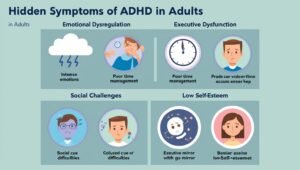ADHD (Attention Deficit Hyperactivity Disorder) is often characterized by a set of visible symptoms that can overshadow the more nuanced and hidden aspects of the condition. To better understand this complex disorder, the concept of the “ADHD iceberg” serves as a powerful metaphor. Just like an iceberg, where only a fraction is visible above the surface while the bulk remains hidden beneath, ADHD presents both prominent and subtle symptoms that can significantly affect an individual’s life. In this post, we’ll explore the ADHD iceberg in detail, examining both the visible and hidden symptoms, and consider the next steps for those affected.
What Is the ADHD Iceberg?
The ADHD iceberg is a conceptual model that illustrates the disparity between the observable symptoms of ADHD and the deeper, often unrecognized challenges that individuals face. While the top of the iceberg represents the behaviors and symptoms that are readily apparent to others—such as inattention, hyperactivity, and impulsivity—the bulk of the iceberg lies beneath the surface, encompassing emotional and cognitive struggles, social challenges, and other difficulties that are less visible but equally impactful.
This model helps to shift the focus from just the visible behaviors to a more holistic understanding of ADHD. Recognizing that ADHD is not simply about being easily distracted or hyperactive can foster empathy and encourage a more supportive approach to managing the condition.
Visible Symptoms of the ADHD Iceberg
Inattention
Inattention is one of the hallmark symptoms of ADHD and is often the most noticeable. Individuals with inattentive symptoms may struggle to:
- Maintain focus: They may find it challenging to concentrate on tasks, especially those that are lengthy or monotonous. This often leads to incomplete assignments, forgotten commitments, and a sense of being easily distracted by external stimuli.
- Organize tasks and activities: People with ADHD may have difficulty organizing their work, leading to messy environments, misplaced items, and missed deadlines.
- Follow through on instructions: Inattentiveness can manifest as a failure to complete tasks or follow through on directions, resulting in frustration for both the individual and those around them.
- Pay attention to details: Errors due to oversight are common, whether in schoolwork, professional tasks, or daily responsibilities. This can affect academic and job performance.
Hyperactivity
Hyperactivity is another visible symptom of ADHD, often characterized by:
- Fidgeting or restlessness: Individuals may find it hard to sit still, leading to constant movement, tapping, or squirming.
- Excessive talking: People with ADHD may speak rapidly or interrupt others, sometimes making social interactions challenging.
- Difficulty engaging in quiet activities: Many individuals with hyperactive symptoms struggle to engage in calm or sedentary activities, preferring more stimulating environments.
- Impulsiveness in physical actions: They might jump into situations without considering the consequences, such as rushing through activities without adequate preparation.
Impulsivity
Impulsivity can manifest as:
- Hasty decision-making: Individuals may act without thinking, leading to poor choices in both personal and professional contexts.
- Interrupting others: Impulsivity often leads to frequent interruptions during conversations, which can strain relationships.
- Emotional outbursts: Individuals might have difficulty regulating their emotions, resulting in sudden and intense reactions to situations.
These visible symptoms are often what draw attention to ADHD and can lead to misunderstandings about the condition. However, they represent just the tip of the iceberg.
Hidden ADHD Iceberg Symptoms
Beneath the surface, there are numerous hidden symptoms that can profoundly impact an individual’s life but are often overlooked. These include:

Emotional Dysregulation
Many individuals with ADHD struggle with managing their emotions. This can lead to:
- Intense feelings: Strong emotional reactions can occur over seemingly minor events, leading to mood swings.
- Difficulty calming down: Once emotionally charged, it can be challenging for individuals to return to a state of calm, affecting their interactions with others.
Executive Dysfunction
Executive functions are critical cognitive processes that help with planning, organization, and self-regulation. Individuals with ADHD often experience:
- Poor time management: Difficulty estimating how long tasks will take or adhering to deadlines can be frustrating.
- Challenges with prioritization: Individuals may struggle to determine which tasks are most important, leading to procrastination or neglect of essential responsibilities.
- Difficulty starting tasks: The initiation of tasks can feel overwhelming, leading to avoidance behaviors.
Social Challenges
Social interactions can be particularly difficult for those with ADHD. Hidden symptoms may include:
- Difficulty reading social cues: Individuals might miss non-verbal signals, leading to misunderstandings in conversations.
- Struggles with relationships: Impulsivity and emotional dysregulation can strain friendships and family relationships, often leading to isolation.
Low Self-Esteem
Many individuals with ADHD face chronic feelings of inadequacy due to the challenges they experience, which can result in:
- Negative self-talk: Internalizing feelings of failure can lead to a damaging self-perception.
- Avoidance of challenges: Fearing failure, individuals might shy away from new experiences, which can hinder personal growth.
Sensory Processing Issues
Some individuals with ADHD may experience heightened sensitivities to sensory inputs, leading to:
- Overwhelm in busy environments: Crowded or noisy places can be particularly distressing, making it hard to concentrate.
- Difficulty with sensory regulation: Individuals may either seek out sensory stimulation (e.g., constant movement) or withdraw from it, affecting their daily functioning.
ADHD Iceberg: Next Steps
Understanding the ADHD iceberg is a crucial first step in addressing the challenges faced by individuals with the disorder. Recognizing both visible and hidden symptoms can lead to more effective management strategies. Here are some next steps to consider:
Seek Professional Evaluation
If you or someone you know exhibits symptoms of ADHD, seeking a comprehensive evaluation from a mental health professional is essential. A thorough assessment can help differentiate ADHD from other conditions and identify the specific challenges an individual faces.
Develop a Personalized Management Plan
Work with a healthcare provider to create a tailored management plan that addresses both visible and hidden symptoms. This plan may include:
- Behavioral therapy: Therapy can help individuals develop coping strategies for emotional dysregulation and executive dysfunction.
- Medication: For some, medication can be a useful tool for managing symptoms, especially those related to inattention and impulsivity.
- Skill-building: Focus on improving organizational and time management skills through practical techniques.
Build a Support Network
Connecting with support groups or individuals who understand ADHD can provide a sense of community and reduce feelings of isolation. Sharing experiences can also offer new strategies for managing challenges.
Educate Yourself and Others
Knowledge is power. Educating yourself about ADHD can help demystify the condition and empower you to advocate for yourself or others. Encourage friends, family, and colleagues to learn about ADHD, fostering a more supportive environment.
Practice Self-Compassion
For individuals with ADHD, practicing self-compassion is crucial. Recognize that the challenges faced are not a reflection of personal failure but rather aspects of a complex neurological condition. Embrace strengths and focus on progress rather than perfection.
Types of Trauma
There are several types of trauma, each with different causes and impacts on individuals:
- Acute Trauma: This type of trauma results from a single, distressing event, such as a car accident, natural disaster, or physical assault. Acute trauma can lead to intense emotional reactions like fear, anxiety, and confusion.
- Chronic Trauma: Chronic trauma occurs from prolonged or repeated exposure to highly stressful events, such as ongoing abuse (physical, emotional, or sexual), domestic violence, or living in a war zone. Over time, chronic trauma can severely impact a person’s mental health and lead to conditions like depression, anxiety, or PTSD (Post-Traumatic Stress Disorder).
- Complex Trauma: Complex trauma arises from exposure to multiple traumatic events, often of an invasive, interpersonal nature. This is common in individuals who have experienced long-term abuse or neglect, particularly during childhood. Complex trauma can significantly impact one’s sense of identity and relationships with others.
- Secondary or Vicarious Trauma: This type of trauma affects individuals who are indirectly exposed to trauma, such as healthcare workers, therapists, or emergency responders who work with trauma survivors. Witnessing or hearing about traumatic events repeatedly can take an emotional toll on caregivers and professionals, leading to symptoms similar to those experienced by trauma victims.
Symptoms of Trauma
Trauma manifests in many ways, and the symptoms can be both psychological and physical. The symptoms of trauma often vary depending on the individual and the nature of the traumatic event(s). Common psychological and emotional symptoms include:
- Flashbacks or reliving the traumatic event
- Nightmares or distressing dreams related to the trauma
- Anxiety and feelings of constant fear or nervousness
- Depression or a pervasive sense of sadness and hopelessness
- Hypervigilance, or being overly aware of danger or threat
- Dissociation, or feeling detached from oneself or reality
- Emotional numbness or a lack of ability to feel emotions
- Anger and irritability over seemingly minor issues
Physical symptoms may include:
- Fatigue or extreme tiredness
- Headaches or body pain with no clear cause
- Sleep disturbances, including insomnia
- Increased heart rate or difficulty breathing during stressful moments
- Tension and restlessness
How Trauma Affects the Brain
Trauma can cause long-lasting changes in the brain. The brain’s fear center, the amygdala, becomes hyperactive, making it difficult for a person to regulate emotions and recognize what is safe versus what is threatening. Additionally, the prefrontal cortex, responsible for decision-making and rational thinking, can become less effective, making it harder to manage stress and emotional responses.
In cases of chronic trauma, the brain remains in a constant state of “fight or flight,” leaving the body and mind exhausted. The person may become hypervigilant, always on edge, and unable to relax even in safe environments.
Conclusion
The ADHD iceberg serves as a powerful metaphor for understanding the complexity of ADHD. While the visible symptoms of inattention, hyperactivity, and impulsivity may dominate discussions, the hidden challenges are equally significant and require attention. By acknowledging the full scope of ADHD, we can foster a more comprehensive understanding, leading to better support and management strategies. Whether you are navigating ADHD yourself or supporting someone who is, recognizing what lies beneath the surface is an essential step toward a more fulfilling and successful life.











